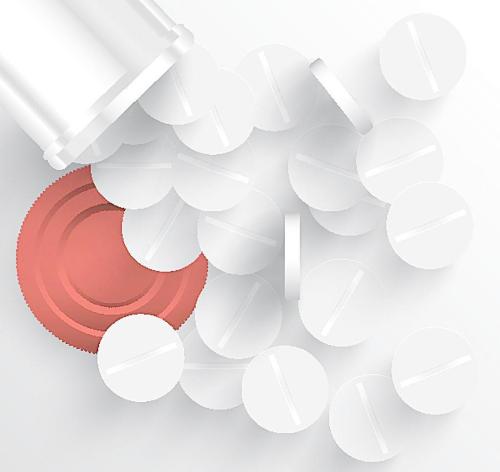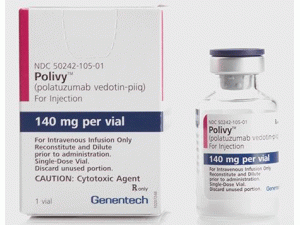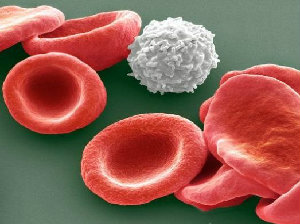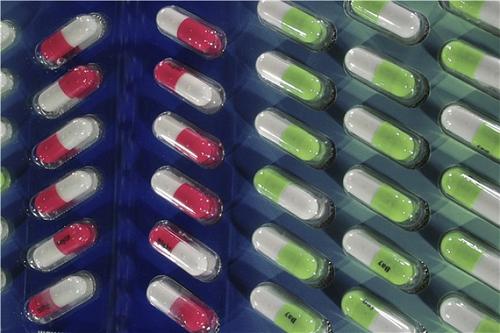贝利司他冻干粉注射剂Beleodaq injection 500mg(belinostat)
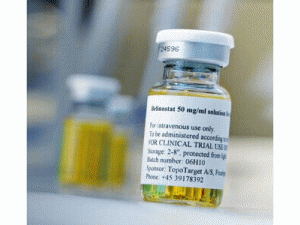 药店国别:
产地国家:美国
处方药:是
所属类别: 500毫克/瓶
包装规格: 500毫克/瓶
计价单位:瓶
生产厂家中文参考译名:
生产厂家英文名:SPECTRUM PHARMS
原产地英文商品名:BELEODAQ injection 500mg/Vial
原产地英文药品名:BELINOSTAT
中文参考商品译名:BELEODAQ注射注射液 500毫克/瓶
中文参考药品译名:注射用贝利司他
曾用名:
简介:
近日,美国FDA批准Beleodaq(belinostat)用于外周T细胞淋巴瘤(PTCL)患者治疗,PTCL是一种罕见并快速增长的非霍奇金淋巴瘤(NHL)。这次的批准是在FDA加速批准程序下完成。PTCL由不同组的疾病组成,这类疾病的淋巴结发生癌变。2014年,美国国家癌症研究所预测70800名美国人将被确诊为NHL,而有18990人会死亡。在北美PTCL占NHLs的比例大约在10%到15%。Beleodaq通过阻止有助于T细胞(一种免疫细胞)发生癌变的酶起作用。这款药物适用于治疗后(复发性)疾病又卷土重来或对以前治疗无效(难治性)的患者。批准日期:2014年7月3日;公司: Spectrum药业公司BELEODAQ(贝利司他[belinostat])用于注射,用于静脉注射美国最初批准:2014年
作用机制
Beleodaq是一种组蛋白去乙酰化酶(HDAC)抑制剂。HDAC催化从组蛋白的赖氨酸残基和一些非组蛋白蛋白中除去乙酰基。在体外,belinostat引起乙酰化组蛋白和其他蛋白质的积累,诱导一些转化细胞的细胞周期停滞和/或凋亡。与正常细胞相比,Belinostat显示出对肿瘤细胞的优先细胞毒性。Belinostat以纳摩尔浓度(<250 nM)抑制组蛋白脱乙酰酶的酶活性。
适应症和用法
Beleodaq是一种组蛋白去乙酰化酶抑制剂,适用于治疗复发或难治性外周T细胞淋巴瘤(PTCL)的患者。基于肿瘤反应和反应持续时间,在加速批准下批准该指示。尚未确定存活率或疾病相关症状的改善。对该指征的持续批准可能取决于验证试验中临床获益的验证和描述。
剂量和给药
Beleodaq的推荐剂量为1000mg/m2,通过静脉输注在21天周期的第1-5天每天一次施用30分钟。可以重复循环直至疾病进展或不可接受的毒性。为了控制不良反应,可能需要治疗中断或中断,有或没有剂量减少25%。剂量形式和强度用于注射:500mg,在单剂量小瓶中的冻干粉末用于重构。
禁忌症
没有。
警告和注意事项
血液学毒性:血小板减少症,白细胞减少症(中性粒细胞减少症和淋巴细胞减少症)和贫血症:监测血细胞计数并改变血液毒性的剂量。感染:严重和致命的感染(例如,肺炎和败血症)。肝毒性:Beleodaq可能引起肝毒性和肝功能试验异常。监测肝功能检查并省略或修改肝脏毒性剂量。肿瘤溶解综合征:监测患有晚期疾病和/或高肿瘤负荷的患者并采取适当的预防措施。胚胎 - 胎儿毒性:Beleodaq给孕妇服用可能会造成胎儿伤害。告知女性在接受Beleodaq时可能对胎儿造成伤害并避免怀孕。
不良反应
最常见的不良反应(> 25%)是恶心,疲劳,发热,贫血和呕吐。
用于特定人群护理
母亲:在Beleodaq治疗期间,应建议女性不要母乳喂养。
包装提供/存储和处理
提供注射用Beleodaq(belinostat)以单瓶小瓶供应; 每个30mL透明小瓶含有相当于500mg belinostat的无菌冻干粉末。NDC 68152-108-09:Beleodaq 30 mL单剂量小瓶的个别纸盒,含有500 mg belinostat。
存储和处理
存放Beleodaq(belinostat),室温20°C至25°C(68°F至77°F)。偏差可在15°C至30°C(59°F至86°F)之间进行。 保留原包装直至使用。[见USP ControlledRoom温度]。Beleodaq是一种细胞毒性药物。
英文版说明书
Approval: 2014Important Safety Information about BELEODAQLow Blood Cell Counts: Patients may experience low blood cell counts. Your doctor will do weekly blood tests to check your blood counts.Low Platelet Count: Lower platelets may cause unusual bleeding, such as nosebleeds, or abnormal bruising. Talk to your doctor right away if this happens.Low Red Blood Cell Count: Lower red blood cell counts may make you feel weak, feel tired, and/or get tired easily. You may appear pale and be short of breath. Contact your doctor if you experience any of these symptoms following treatment with BELEODAQ.Low White Blood Cell Count: Lower white blood cell counts can reduce the body’s defenses against infection. If you have any of the following signs or symptoms of infection (fever, chills, cough, shortness of breath, pain or burning on urination, muscle aches, or worsening skin problems), tell your doctor right away. Serious illness or death could result if such infections are not treated when white blood cell counts are very low.Serious Infections: BELEODAQ may lower the ability of your immune system to fight infections. People receiving BELEODAQ may develop serious infections that can sometimes lead to death. You should not receive BELEODAQ if you have an ongoing active infection. You should tell your doctor if you have any signs or symptoms of an infection.Liver Problems: BELEODAQ may cause liver problems which can lead to death. Your doctor will do blood tests during your treatment with BELEODAQ to check for liver problems. Tell your doctor right away if you have any of the following signs or symptoms of liver problems: yellowing of the skin or the white part of your eyes, dark urine, itching, or pain in the right upper stomach area.Tumor Lysis Syndrome (TLS): BELEODAQ can cause the fast breakdown of certain types of cancer cells. This can lead to TLS. As tumor cells die, they break apart and release their contents into the blood causing a change in certain chemicals in the bloodstream, which may cause damage to organs, including the kidneys, heart, and liver. Your doctor may do blood tests to check you for TLS and treat you for TLS if needed.Nausea, Vomiting, and Diarrhea: Nausea, vomiting, and diarrhea are common with BELEODAQ and can sometimes be serious. Medicines can be given that may help reduce these symptoms. If you experience any of these symptoms, tell your doctor.Pregnancy and Nursing: Tell your doctor if you are pregnant or plan to become pregnant. BELEODAQ can harm your unborn baby. BELEODAQ has not been studied in pregnant women. Tell your doctor if you are breastfeeding or plan to breast-feed. It is not known if BELEODAQ will pass into your breast milk. You and your doctor should decide if you will receive BELEODAQ or breastfeed. You should not do both.Other common side effects may include:FatigueFeverThese are not all of the potential side effects of BELEODAQ. If you have any side effect that bothers you or that doesn’t go away, be sure to talk with your healthcare professional.Tell your doctor about your medical conditions, including infection, chemotherapy treatment, liver and kidney problems, nausea, vomiting, or diarrhea.Tell your doctor about all the medicines you take, including prescription and nonprescription medicines, vitamins, and herbal supplements. Some medicines may affect how BELEODAQ works, and BELEODAQ may affect how other medicines work. Especially tell your doctor if you are also taking medications such as Nexavar (sorafenib), Tarceva (erlotinib), Lopid (gemfibrozil), or ketoconazole. Ask your doctor or pharmacist if you are not sure if your medicine should be avoided while taking BELEODAQ. Know the medicines you take. Keep a list of them and show it to your doctor or pharmacist each time you start a new medicine.
药店国别:
产地国家:美国
处方药:是
所属类别: 500毫克/瓶
包装规格: 500毫克/瓶
计价单位:瓶
生产厂家中文参考译名:
生产厂家英文名:SPECTRUM PHARMS
原产地英文商品名:BELEODAQ injection 500mg/Vial
原产地英文药品名:BELINOSTAT
中文参考商品译名:BELEODAQ注射注射液 500毫克/瓶
中文参考药品译名:注射用贝利司他
曾用名:
简介:
近日,美国FDA批准Beleodaq(belinostat)用于外周T细胞淋巴瘤(PTCL)患者治疗,PTCL是一种罕见并快速增长的非霍奇金淋巴瘤(NHL)。这次的批准是在FDA加速批准程序下完成。PTCL由不同组的疾病组成,这类疾病的淋巴结发生癌变。2014年,美国国家癌症研究所预测70800名美国人将被确诊为NHL,而有18990人会死亡。在北美PTCL占NHLs的比例大约在10%到15%。Beleodaq通过阻止有助于T细胞(一种免疫细胞)发生癌变的酶起作用。这款药物适用于治疗后(复发性)疾病又卷土重来或对以前治疗无效(难治性)的患者。批准日期:2014年7月3日;公司: Spectrum药业公司BELEODAQ(贝利司他[belinostat])用于注射,用于静脉注射美国最初批准:2014年
作用机制
Beleodaq是一种组蛋白去乙酰化酶(HDAC)抑制剂。HDAC催化从组蛋白的赖氨酸残基和一些非组蛋白蛋白中除去乙酰基。在体外,belinostat引起乙酰化组蛋白和其他蛋白质的积累,诱导一些转化细胞的细胞周期停滞和/或凋亡。与正常细胞相比,Belinostat显示出对肿瘤细胞的优先细胞毒性。Belinostat以纳摩尔浓度(<250 nM)抑制组蛋白脱乙酰酶的酶活性。
适应症和用法
Beleodaq是一种组蛋白去乙酰化酶抑制剂,适用于治疗复发或难治性外周T细胞淋巴瘤(PTCL)的患者。基于肿瘤反应和反应持续时间,在加速批准下批准该指示。尚未确定存活率或疾病相关症状的改善。对该指征的持续批准可能取决于验证试验中临床获益的验证和描述。
剂量和给药
Beleodaq的推荐剂量为1000mg/m2,通过静脉输注在21天周期的第1-5天每天一次施用30分钟。可以重复循环直至疾病进展或不可接受的毒性。为了控制不良反应,可能需要治疗中断或中断,有或没有剂量减少25%。剂量形式和强度用于注射:500mg,在单剂量小瓶中的冻干粉末用于重构。
禁忌症
没有。
警告和注意事项
血液学毒性:血小板减少症,白细胞减少症(中性粒细胞减少症和淋巴细胞减少症)和贫血症:监测血细胞计数并改变血液毒性的剂量。感染:严重和致命的感染(例如,肺炎和败血症)。肝毒性:Beleodaq可能引起肝毒性和肝功能试验异常。监测肝功能检查并省略或修改肝脏毒性剂量。肿瘤溶解综合征:监测患有晚期疾病和/或高肿瘤负荷的患者并采取适当的预防措施。胚胎 - 胎儿毒性:Beleodaq给孕妇服用可能会造成胎儿伤害。告知女性在接受Beleodaq时可能对胎儿造成伤害并避免怀孕。
不良反应
最常见的不良反应(> 25%)是恶心,疲劳,发热,贫血和呕吐。
用于特定人群护理
母亲:在Beleodaq治疗期间,应建议女性不要母乳喂养。
包装提供/存储和处理
提供注射用Beleodaq(belinostat)以单瓶小瓶供应; 每个30mL透明小瓶含有相当于500mg belinostat的无菌冻干粉末。NDC 68152-108-09:Beleodaq 30 mL单剂量小瓶的个别纸盒,含有500 mg belinostat。
存储和处理
存放Beleodaq(belinostat),室温20°C至25°C(68°F至77°F)。偏差可在15°C至30°C(59°F至86°F)之间进行。 保留原包装直至使用。[见USP ControlledRoom温度]。Beleodaq是一种细胞毒性药物。
英文版说明书
Approval: 2014Important Safety Information about BELEODAQLow Blood Cell Counts: Patients may experience low blood cell counts. Your doctor will do weekly blood tests to check your blood counts.Low Platelet Count: Lower platelets may cause unusual bleeding, such as nosebleeds, or abnormal bruising. Talk to your doctor right away if this happens.Low Red Blood Cell Count: Lower red blood cell counts may make you feel weak, feel tired, and/or get tired easily. You may appear pale and be short of breath. Contact your doctor if you experience any of these symptoms following treatment with BELEODAQ.Low White Blood Cell Count: Lower white blood cell counts can reduce the body’s defenses against infection. If you have any of the following signs or symptoms of infection (fever, chills, cough, shortness of breath, pain or burning on urination, muscle aches, or worsening skin problems), tell your doctor right away. Serious illness or death could result if such infections are not treated when white blood cell counts are very low.Serious Infections: BELEODAQ may lower the ability of your immune system to fight infections. People receiving BELEODAQ may develop serious infections that can sometimes lead to death. You should not receive BELEODAQ if you have an ongoing active infection. You should tell your doctor if you have any signs or symptoms of an infection.Liver Problems: BELEODAQ may cause liver problems which can lead to death. Your doctor will do blood tests during your treatment with BELEODAQ to check for liver problems. Tell your doctor right away if you have any of the following signs or symptoms of liver problems: yellowing of the skin or the white part of your eyes, dark urine, itching, or pain in the right upper stomach area.Tumor Lysis Syndrome (TLS): BELEODAQ can cause the fast breakdown of certain types of cancer cells. This can lead to TLS. As tumor cells die, they break apart and release their contents into the blood causing a change in certain chemicals in the bloodstream, which may cause damage to organs, including the kidneys, heart, and liver. Your doctor may do blood tests to check you for TLS and treat you for TLS if needed.Nausea, Vomiting, and Diarrhea: Nausea, vomiting, and diarrhea are common with BELEODAQ and can sometimes be serious. Medicines can be given that may help reduce these symptoms. If you experience any of these symptoms, tell your doctor.Pregnancy and Nursing: Tell your doctor if you are pregnant or plan to become pregnant. BELEODAQ can harm your unborn baby. BELEODAQ has not been studied in pregnant women. Tell your doctor if you are breastfeeding or plan to breast-feed. It is not known if BELEODAQ will pass into your breast milk. You and your doctor should decide if you will receive BELEODAQ or breastfeed. You should not do both.Other common side effects may include:FatigueFeverThese are not all of the potential side effects of BELEODAQ. If you have any side effect that bothers you or that doesn’t go away, be sure to talk with your healthcare professional.Tell your doctor about your medical conditions, including infection, chemotherapy treatment, liver and kidney problems, nausea, vomiting, or diarrhea.Tell your doctor about all the medicines you take, including prescription and nonprescription medicines, vitamins, and herbal supplements. Some medicines may affect how BELEODAQ works, and BELEODAQ may affect how other medicines work. Especially tell your doctor if you are also taking medications such as Nexavar (sorafenib), Tarceva (erlotinib), Lopid (gemfibrozil), or ketoconazole. Ask your doctor or pharmacist if you are not sure if your medicine should be avoided while taking BELEODAQ. Know the medicines you take. Keep a list of them and show it to your doctor or pharmacist each time you start a new medicine.
用药温馨提示:当您服用此药物时,需定期接受医疗专业人士的检查,以便随时针对其药效、副作用等情况进行监测。本网站所包含的信息旨在为患者提供帮助,不能代替医学建议和治疗。
药品价格查询,专业药品查询网站,药品说明书查询,药品比价 » 贝利司他冻干粉注射剂Beleodaq injection 500mg(belinostat)
药品价格查询,专业药品查询网站,药品说明书查询,药品比价 » 贝利司他冻干粉注射剂Beleodaq injection 500mg(belinostat)

